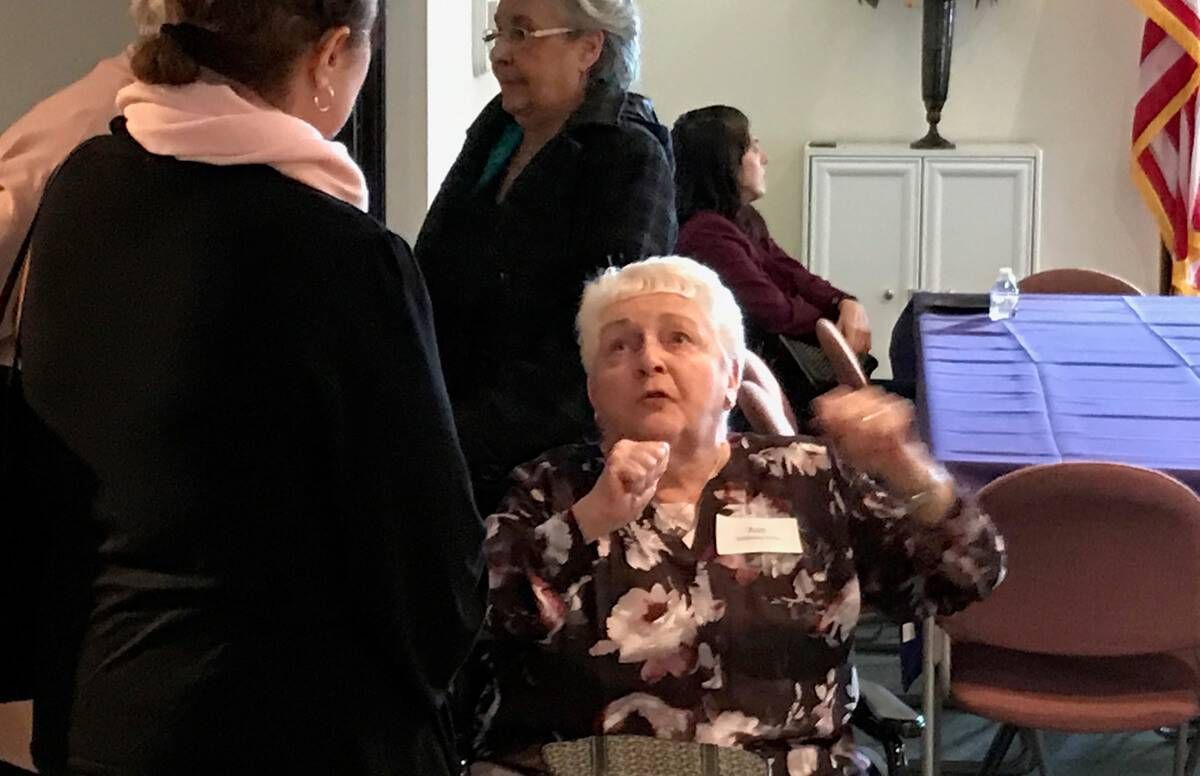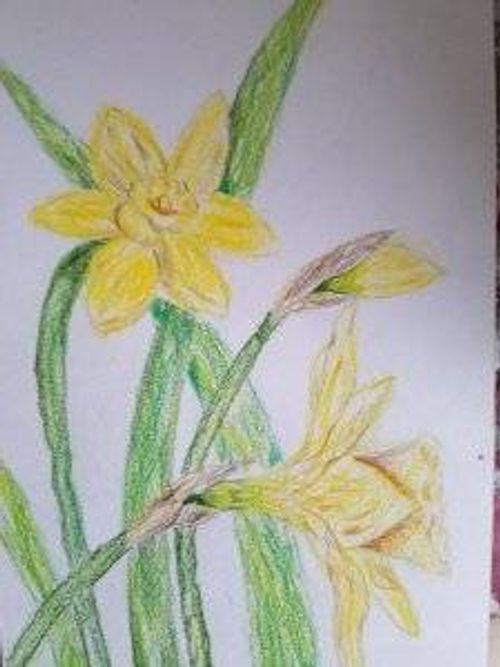Losing Herself in Art and Finding Joy
A lifetime of challenges has never slowed the author's spirited mother
My mother, Anne Pols, celebrated her 87 birthday in November. In that same month, she also made her art show debut, exhibiting a half-dozen freehand colored pencil drawings at the Long Island Museum in Stony Brook, N.Y.

She and six other residents of her assisted living program at Jefferson’s Ferry contributed 25 pieces to a show called "Through Our Eyes." The accomplishment is particularly sweet for my mother for several reasons. She has lived with a physical disability for most of her life. She took up drawing at 86. And six months prior to the show, she lost, in a single instant, most of the vision in her left eye.
One of my sisters said that days after the eye failed, my mother told her she was working on regaining her appetite. “Well, you’ve been though a lot in the last few days,” my sister said. To which our mother replied, “That’s history.”
She returned to her art classes a few weeks later.
Through Her Eyes
In our youth, my three sisters and I were never far from seeing a somewhat terrifying childhood through our mother’s eyes. At six, she nearly died from a ruptured appendix. In the hospital, she was forced to lay on her belly for a month to allow infected fluids to drain from the open surgical incision. A well-meaning relative doused the wound with perfume to diminish the odor. “That hurt,” our mom told us with a whistle.

At nine, she suffered a stroke — likely a burst aneurysm. There were no CAT scans or MRIs then, so the diagnoses ranged, she told us, from cerebral palsy to polio to some kind of infectious disease. In any case, she lost the use of the right side of her body and her speech as well. Her Irish immigrant family didn’t have much, so she was treated at public hospitals. She recalled for us the times she was paraded, naked or partly clothed, across a stage for a roomful of doctors-in-training. “I’d rather do that than go to the dentist any day,” she’d tell us.
When she was 12, her mother died of her own cerebral hemorrhage. Her father followed her mother to his grave within months, succumbing either “to the drink” or tuberculosis or a broken heart, depending on the telling. It didn’t matter why, we learned. What did matter was that her beloved Aunt Mary (barely a decade older than my mother at the time) and Uncle Bill took my mother and her siblings in after they were orphaned. These fine people supported my mother through years of physical therapy and multiple orthopedic surgeries in her teens, and, in fact, for the rest of their also tragically brief lives.
Mild but persistent right-sided weakness and a tendency of her right arm to tighten in spasticity kept my mother from nothing but learning to drive. An occasional word-finding problem showed up most often in calling her four sons-in-law by the wrong names, errors over which she was frequently the first to laugh out loud.
Learning to Draw
At the exhibit, my mother’s drawings are small in scale but realistic, colorful and expertly shaded. In some, she uses a brush to wash over the pencil for a watercolor effect. The subject is generally still life: a cornucopia, a parrot, a bowl of fruit, daffodils.
The daffodil drawing was one of my mother’s first, and when I saw it, it took my breath away. Not only was it was expertly drawn, it reminded my sisters and me of one of my father’s favorite poems. He was the love of her life but is gone nearly six years now, yet another in a series of losses which our mother appears, most times, to take in stride.
My mother started Saturday morning art classes about a year ago, with an accomplished Long Island artist she knows only as Jill. The class is one of many offered by the fine recreational therapy staff at my mother’s assisted living home. She enrolled in part because there wasn’t a lot of other programming on weekends: “It was something to do on a Saturday morning,” she said, adding, “something I was interested in.”
Although she writes with her weaker right hand (assisting with a steadying grip on the wrist with her left hand) she draws with the left. “It’s easier to control,” she said.
The class started with simple coloring of already-drawn designs, which my mother enjoyed, but soon prompted her to tell Jill, “Let me see if I can copy that.” She did. “Then I colored it and watercolored it, too,” she said with satisfaction.
Jill is a constant source of expertise, support and encouragement. “She taught me all about the shading,” my mother said. “That’s what makes it 3-D.”
I do not recall one incident in my mother’s life up to now where she made art for its own sake. She cooked just about every meal we ate, crocheted hats and blankets and sewed some of our clothes — surely artistic endeavors — but always in service to her family.
Not this time. Not with this pursuit of drawing. One of my favorite things about the exhibit was watching my mother, now unable to stand or walk independently and so using a wheelchair for mobility, crane her neck upwards toward exhibit attendees (mostly strangers) to respond to their comments and questions. Her face is animated. She laughs often. Her hands fly up in enthusiasm. She is an artist discussing her work, her process. Her self.
Self and Others
Contrary to much of today’s advice about being one’s own biggest advocate, my sisters and I were raised (in a fairytale compared to our mother’s childhood) with the understanding that “Self-praise is no praise at all.”
I hope it was not only me, among the four of us sisters, whose ego was periodically trimmed by our mother’s quick-tempered, “Who the hell do you think you are?” Let’s just say there wasn’t much discussion about self-actualization.
And yet, the image of her animation at the exhibit stays with me. What is it in drawing that gives her this joy?
In our daily phone calls what I hear most is how time flies — how, in fact, she loses her self — when she’s drawing. “I look up and two hours have passed,” she says. “It relaxes me. It’s like meditation.”
When pressed, she offers just a touch more: “I think that something special came out of me when I started those classes.” I ask her if she feels in any way that she has found herself through this art. “I know who I am,” she informs me, somewhat curtly. “I don’t need to find myself.”
As to the question of what might have come of it all had she started earlier, she is adamant: “I never think about that. My life went the way it did and it was full of love, consideration and respect.”
And now, Saturday morning art classes with Jill.

